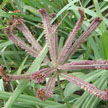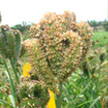Nursery Management
Preparation of Nursery
The seeds are raised in a well prepared nursery beds during the months of May – June and the seedlings becomes ready for transplanting after 3 to 4 weeks.
-
Land Preparation
-
Raised bed formation
-
Selection of seeds
-
Seed treatment
-
Sowing of seeds
-
Water management
-
Crop protection
-
Pulling out the seedlings for treatment
-
Seedling treatment
Land Preparation
|
 |
 Top of page
Top of page
Raised bed formation
|
 |
 Top of page
Top of page
Selection of seeds
|
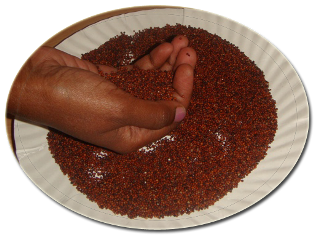 |
 Top of page
Top of page
Seed Treatment
i. Seed treatment with chemicals
|
 Top of page
Top of page
ii. Seed treatment with bio fertilizers
|
Procedure for inoculating seeds with bio-fertilizers
- Bio-fertilizer culture specific to the crop is to be used @ 25 g per kg of seeds
- Sticker solution is necessary for effective seed inoculation. This can be prepared by dissolving 25 g jaggery or sugar in 250 ml water and boiling for 5 minutes. The solution thus prepared is cooled
- Smear the seeds well using the required quantity of sticker solution. Then add culture to the seeds and mix thoroughly so as to get a fine coating of culture on the seeds
- The culture-coated seed is to be dried well in shade to avoid clumping of seeds
- Use inoculated seeds for sowing
 Top of page
Top of page
iii. Seed treatment with cow urine
|
 Top of page
Top of page
Sowing of seeds
|
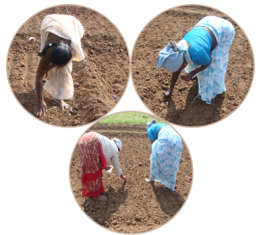 |
 Top of page
Top of page
Water Management
Provide one inlet to each nursery unit. Allow water to enter through the inlet and cover all the channels around the beds. Allow the water in the channels to rise till the raised beds are wet and then cut off water. Adjust the frequency of irrigation according to the soil type.
No. of Irrigations |
Red Soils |
Heavy Soils |
|---|---|---|
First |
Immediately after sowing |
Immediately after sowing |
Second |
3rd day after sowing |
4thday after sowing |
Third |
7th day after sowing |
9th day after sowing |
Fourth |
12th day after sowing |
16th day after sowing |
Fifth |
17th day after sowing |
----- |
|
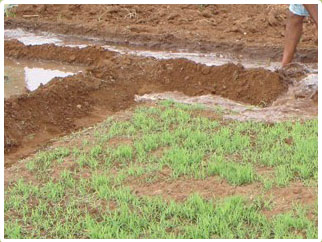 |
 Top of page
Top of page
Crop Protection
i. Cut Worm
Larva feed leaves especially in nursery. Larvae hide in the soil during daytime and feed on leaves at night. Young caterpillars cut the seedlings at the base. Finally it defoliates completely. This Pest is controlled by spraying Endosulfan 35EC @ 0.75 lit/ha or Carbaryl 50WP @ 2.5 Kg/ha or Chlorpyriphos 20EC @ 2lit/ha or Phasolone 35EC @ 1.25 lit/ha. Removing the weeds and plant residues in the nursery. Put the poison bait of wheat bran – 1Kg + Monocrotophos (10ml) +Jaggery-100gm + Water to moisten the bait. |
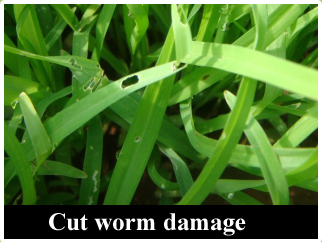 |
 Top of page
Top of page
ii. Grasshopper
It is a polyphagous insect, which feed many other plants. It feeds on foliage and tender shoots of ragi seedlings. Nymph and adult defoliate the crop and make marginal notchings in the leaves. The long term control of grasshoppers is possible through the use of cultural practices like tillage, fall clean-up, trap cropping, early seeding and early harvest. Spraying Endosulfan 35EC 400 ml/lit or Carbaryl 50WP 400g/lit of water. |
 |
 Top of page
Top of page
iii. Blast
The infection appears in the nursery from the second week after germination. Spindle shaped spots appear on the leaves with yellow margin and greyish centre in the initial stages. Later the centre become whitish grey and disintegrates. Finally the young leaves dry in the nursery itself. This disease can be controlled by spraying any one of the following fungicides Carbendazim 0.1% or Edifenphos 10 ml in 10 litres of water using a high volume sprayer which cover 3 cents nursery area on 10 to 12 days after sowing. Seed treatment with carbendazim @ 1gm/Kg of seeds. Spary Pseudomonas at 2g/lit of water immediately and after noticing the symptoms. Grow resistant varieties like CO RA(14), Paiyur (RA)-2, GPU-28,GPU-45,GPU-48, L-5. Use healthy ragi seeds for sowing which will avoid the blast incidence. |
 |
 Top of page
Top of page
iv. Seedling Blight
The pathogen affects both seedling and the adult plants. The first symptom appears on the seedlings as minute, oval, light brown lesions on the young leaves and become dark brown lesions. As the seedlings develop, these enlarge into elongagte lesions, about 1 cm.in length and 1 to 2mm.in width and become dark brown. Several such lesions coalesce to form large patches of infection on the leaf blade. The affected blades wither prematurely and the seedlings may be killed. This disease can be controlled by Spraying Mancozeb at 1.25Kg/ha or DithaneZ-78 (2g/lit of water) or 1% Bordeaux mixture or Copper oxychloride. Seed treatment with Captan or Thiram at 4g/kg of seeds. Uproot and destroy the diseased plant soon after detecting in the field. |
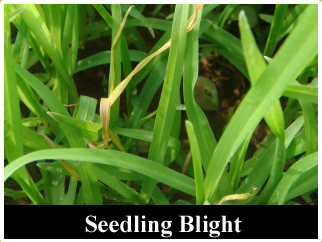 |
 Top of page
Top of page
Pulling out the seedlings for treatment
Pull out seedlings on the 17th to 20th day of sowing for planting. The optimum age of seedling for transplanting depends on variety and its duration. Transplanting generally is done manually by pressing its roots with thumbs on wet or loose soil. Age of seedlings is one of the important factors in deciding the growth of seed crop and yield. Transplanting of too young or too old seedlings will adversely affect the yield. Avoid aged seedlings for transplantation.
|  |
 Top of page
Top of page
Seedlings treatment
Before transplanting, treatment of seedling with biofertilizers is beneficial for increasing the crop yield. The method of application is as follows.
|
